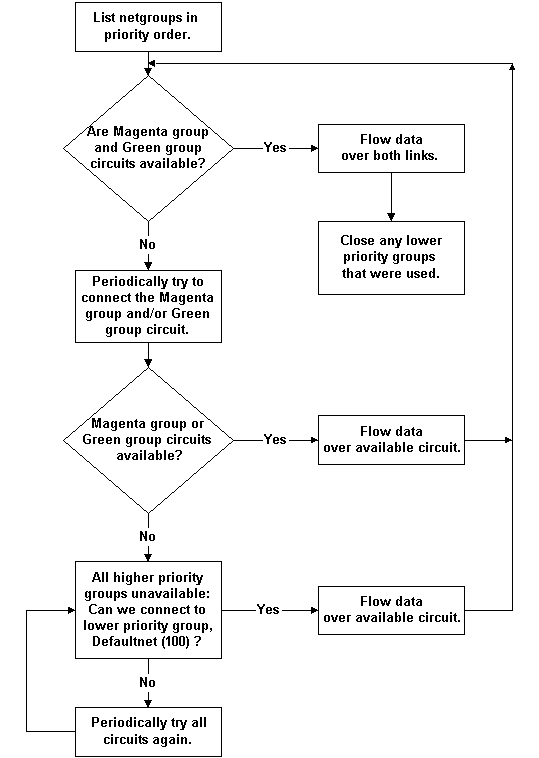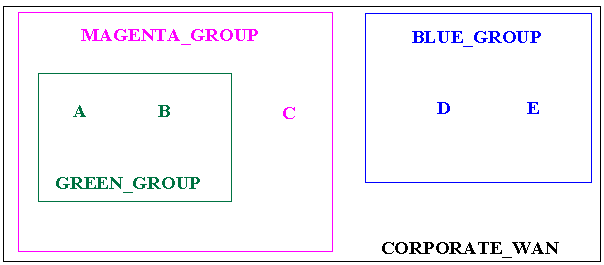Setting Up a Tuxedo Application
|
|
Setting Up the Network for a Distributed Application
This topic includes the following sections:
- Configuring the Network for a Distributed Application
- How Data Moves Over a Network
- How Data Moves Over Parallel Networks
- Example of a Network Configuration for a Simple Distributed Application
- How Failover and Failback Work in Scheduling Network Data
- Example Configuration of Multiple Netgroups
Configuring the Network for a Distributed Application
A distributed application is an application that runs on multiple computers, each of which supports an installation of the BEA Tuxedo system. These computers are connected and can communicate with each other through a network that includes hardware, software, access methods, and communication protocols. The BEA Tuxedo system encodes, routes, and decodes messages, and uses the network to ship those messages between machines. The system performs these tasks automatically.
To configure the networking functionality required to support a distributed application, include the following entries in the configuration file.
How Data Moves Over a Network
In a distributed application, data is sent across the network as follows:
- At the sending end—the
BRIDGEsends a message todestination_machineby writing the message to a virtual circuit and delegating, to the operating system, responsibility for sending it. The operating system retains a copy of every pending message. If a network error occurs, however, pending messages are lost. - At the receiving end—the
BRIDGEprocess listens on a particular network address for incoming messages.
How Data Moves Over Parallel Networks
In a distributed application there are several advantages to using parallel data circuits for sending data across the network:
- By listening at more than one address, the
BRIDGEachieves higher availability. - By sending data simultaneously on parallel data circuits, the
BRIDGEcan achieve a higher throughput, if the network was the limiting factor before. - When you configure parallel data circuits, the software does not necessarily fail to deliver a message if the original destination circuit is busy. The system attempts to schedule traffic over the circuit with the highest network group number (
NETGRPNO). If this circuit is busy, the traffic is automatically scheduled over the circuit with the next (that is, the second highest) network group number. When all circuits are busy, data is queued until a circuit is available.
Before making a decision to use parallel data circuits, however, you should determine whether it will be important, in your application, for messages to be kept in sequence. The system guarantees that conversational messages are kept in the correct sequence by binding the conversation connection to one particular data circuit.
If your application will require all messages to be kept in sequence, you must program the application to keep track of the sequence for nonconversational messages. If you are using this approach, you may not want to configure parallel data circuits.
The following figure describes how data flows when one machine tries to contact another. The figure is based on a sample scenario involving two machines: machine A and machine B. First, the BRIDGE identifies the network groups that are common to both machines: the MAGENTA_GROUP, the GREEN_GROUP, and the DEFAULTNET.
Data flows in parallel on network groups with the same priority (that is, groups for which the same value is assigned to the NETPRIO parameter). Network groups with different priorities are used for failover.
Figure 11-1 Flow of Data over the BRIDGE
Example of a Network Configuration for a Simple Distributed Application
The following example shows how to configure a simple network:
# The following configuration file excerpt shows a NETWORK
# section for a 2-site configuration.
*NETWORK
SITE1 NADDR="//mach1:80952"
NLSADDR="//mach1:serve"
#
SITE2 NADDR="//mach386:80952"
NLSADDR="//mach386:serve"
How Failover and Failback Work in Scheduling Network Data
Data flows over the highest available priority circuit. If all network groups have the same priority, data travels over all networks simultaneously. If all circuits at the current priority fail, data is sent over the next lower priority circuit. This process is called failover. When failover occurs, the failed connections are retried periodically.
When higher priority network connections are reestablished, failback occurs and no further data is scheduled for the lower priority connection. The lower priority connection is disconnected in an orderly fashion.
If attempts to connect to all network addresses have been made and have failed, new attempts to connect are made the next time application or system data needs to be sent between machines.
Example Configuration of Multiple Netgroups
The hypothetical First State Bank has a network of five machines (A-E). These machines are configured in four network groups and each machine is used in two or three groups.
Note: The hardware and system software prerequisites for configuring multiple network groups (NETGROUPS) are beyond the scope of this document. For example, machines are frequently required to belong to more than one physical network. Each TCP/IP symbolic address must be identified in the /etc/hosts file or in the DNS (Domain Name Services).
In the following example, it is assumed that in addresses written in the form //A_CORPORATE:5345, the string A_CORPORATE is specified in the /etc/hosts file or in DNS.
The four groups in the First State Bank network include:
DEFAULTNET(the default network, which is the corporate WAN)MAGENTA_GROUP(a LAN)BLUE_GROUP(a LAN)GREEN_GROUP(a private LAN that provides high-speed, fiber, point-to-point links between member machines)
All machines belong to DEFAULTNET (the corporate WAN). In addition, each machine is associated with either the MAGENTA_GROUP or the BLUE_GROUP. Finally, some machines in the MAGENTA_GROUP also belong to the GREEN_GROUP. The following diagram illustrates group assignments for the network.
Figure 11-2 Example Network Groups
In this example, machines A and B have addresses for the following:
Machine C has addresses for the following:
Machines D and E have addresses for the following:
Because the local area networks are not routed to all locations, machine D (in the BLUE_GROUP LAN) may contact machine A (in the GREEN_GROUP LAN) only by using the single address they have in common: the corporate WAN network address.
Configuration File for the Sample Network
To set up the configuration described in the preceding section, the First State Bank administrator defines each group in the NETGROUPS and NETWORK sections of the UBBCONFIG file as follows:
*NETGROUPS
DEFAULTNET NETGRPNO = 0 NETPRIO = 100 #default
BLUE_GROUP NETGRPNO = 9 NETPRIO = 200
MAGENTA_GROUP NETGRPNO = 125 NETPRIO = 200
GREEN_GROUP NETGRPNO = 13 NETPRIO = 300
*NETWORK
A NETGROUP=DEFAULTNET NADDR="//A_CORPORATE:5723"
A NETGROUP=MAGENTA_GROUP NADDR="//A_MAGENTA:5724"
A NETGROUP=GREEN_GROUP NADDR="//A_GREEN:5725"
B NETGROUP=DEFAULTNET NADDR="//B_CORPORATE:5723"
B NETGROUP=MAGENTA_GROUP NADDR="//B_MAGENTA:5724"
B NETGROUP=GREEN_GROUP NADDR="//B_GREEN:5725"
C NETGROUP=DEFAULTNET NADDR="//C_CORPORATE:5723"
C NETGROUP=MAGENTA_GROUP NADDR="//C_MAGENTA:5724"
D NETGROUP=DEFAULTNET NADDR="//D_CORPORATE:5723"
D NETGROUP=BLUE_GROUP NADDR="//D_BLUE:5726"
E NETGROUP=DEFAULTNET NADDR="//E_CORPORATE:5723"
E NETGROUP=BLUE_GROUP NADDR="//E_BLUE:5726"
Assigning Priorities for Each Network Group
Assigning priorities appropriately for each NETGROUP enables you to maximize the capability of network BRIDGE processes. When determining NETGROUP priorities, keep in mind the following considerations:
- Data flows over only the highest available priority circuit.
- If all network groups have the same priority, data travels over all circuits simultaneously.
- If all circuits at the current priority fail, data is sent over the next lower priority circuit.
- When a higher priority circuit becomes available, data flows over it.
- All unavailable higher priority circuits are retried periodically.
- After connections to all network addresses have been tried and have failed, connections are tried again the next time data needs to be sent between machines.
- The default value of
NETPRIOis 100.
Example Assignment of Priorities to Network Groups
The following diagram shows how the First State Bank administrator assigns priorities to the available network groups.
Figure 11-3 Assigning Priorities to Network Groups
The following priorities are assigned:
Example NETGROUP and NETWORK Sections
The lowest priority among network groups is reserved for the default network group, that is, the group that is not used unless all others are unavailable. Therefore, if you want to limit the use of a particular network, such as a satellite link for which per-minute fees are incurred, designate that network as the default network group.
You can assign a network priority to the default network group by setting the NETPRIO parameter for DEFAULTNET just as you do for any other group. If you do not specify a priority for DEFAULTNET, a default of 100 is used, as shown in the following example:
*NETGROUP
DEFAULTNET NETGRPNO = 0 NETPRIO = 100
For DEFAULTNET, the value of the network group number (NETGRPNO) must be zero; any other number is invalid. The value of NETGRPNO must be unique for each entry.
On the other hand, the same value of NETPRIO may be assigned to multiple network groups. For example, in the First State Bank configuration file, the same network priority (NETPRIO=200) is assigned to both the MAGENTA_GROUP and the GREEN_GROUP.
Each network address (NETWORK) is associated by default with the DEFAULTNET network group. This parameter may be specified explicitly for either of two reasons: to maintain uniformity among entries, or to associate the network address being defined with a second network group.
*NETWORK
D NETGROUP=BLUE_GROUP NADDR="//D_BLUE:5726"


